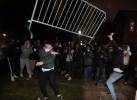Wood chip mulch can be used between strawberry plants

Q: You have converted me to the doctrine of using wood chip mulch. Is there any reason why I couldn’t use wood chips in my strawberry bed? My wife used to put strawberries in pots, and they never did well.
A: You can use wood chip mulch between strawberries. Apply compost right over the top of the wood chip mulch and water it into the soil when fertilizing. You will have to remove the mulch after two or three years when you pull out the old mature plants and replant with new ones.
Plant in mid-August, not in the spring. This is a mistake many people make. You may have trouble finding plants this time of the year, since most information is focused on spring planting. But strawberries will struggle when temperatures get hot after planting in the spring.
Improve the soil 50-50 with compost mixed with the existing soil before planting. I would include a starter fertilizer such as 0-45-0 mixed with that soil mix. A good quality compost can act as a fertilizer, so don’t be afraid to apply it every three to four months after planting.
Here’s where I differ from what you might read. Plant strawberry plants about 12 inches apart in rows 12 inches apart and remove runners when you see them. Some people also recommend removing the flowers as well. Planting in rows helps you find the berries later when the plants are full.
Plants should not crowd each other. You should see a slight separation between them for good production. Sunlight should hit the plant on all sides.
Select an everbearing type of strawberry rather than a main crop type. Main crop types produce berries only once a year. Older varieties of everbearing types like Fort Laramie, Quinault and Ogallala perform fine here during cool weather.
Everbearing types trickle their production throughout the year. This trickling makes them more productive here when the weather is favorable. They will produce fresh berries for two to three years before the plants need to be replaced.
Strawberries will not set fruit very well when the temperature is above 85 F. This makes summer fruit production difficult with June-bearing types of strawberries.
Keep plants alive during summer months until the cooler fall months return. Put them under 30 to 40 percent shade cloth draped on 3-foot-tall hoops during the summer months. Lay a frost cover over the top when temperatures are expected to freeze.
Water strawberries with in-line drip tubing running the entire length of the raised beds and spaced to 12 inches apart. Hand watering with the hose is very difficult. Keep soil moist but not wet to prevent root disease problems.
Q: When is the best time to stop cutting asparagus here in Las Vegas? I have a bumper crop this year.
A: There are a couple of ways to determine when to stop cutting asparagus. The first way is when the spears start to get thin. If you have thin spears, it is a sign the stored food in the roots is starting to get in short supply.
Stop harvesting. Let the tops grow until late December and then cut them to the ground; fertilize with compost to get ready for the next season’s production.
The second way is a calendar method. Cut for about two to three months in early spring, let the ferns grow and cut these ferns to the ground in late December. Fertilize with compost and start the cycle again.
By the way, remove the spears from below ground with an asparagus knife, not by snapping off the spears. An asparagus knife is like the old-fashioned, forked dandelion remover.
In a pinch, I use a long knife and push it into the ground, cutting the spear. Snapping the spears leaves a stubble on the soil surface that interferes with next year’s harvest and management.
Wash the spears and recut the spears to the proper length for cooking. Use the bottom parts of the spears, peeled, for asparagus soup.
Q: You posted a graph on your blog of inches of water that plants use each day during each month of the year. How many gallons is an inch of water?
A: I bet you want to know in minutes. That’s one problem when talking about irrigation. Irrigation clocks measure the volume of water in minutes. We apply water as a depth or in gallons, not minutes.
An acre-foot of water is roughly 325,900 gallons. An acre-inch is roughly 1/12 of that, which is 27,158 gallons. One inch of water in a one-cubic-foot container is 7.48/12 = 0.62 gallons.
One inch of water applied to pure sand penetrates to a depth of about 20 inches — fine sand, 14 inches deep; fine sandy loam, 10 inches; silt loam, 7 inches; and clay loam, 6 inches.
The amount of water to apply is determined by the depth of its roots. The shallowest rooted plants are lawns, annual flowers and annual vegetables.
We assume the depth of their roots is less than a foot. The next deepest-rooted plants are 2- to 4-foot-tall perennials with a rooting depth of 12 to 18 inches. And finally, trees and large shrubs are the deepest with an effective route depth of about 24 inches.
Larger plants are given more water but watered less often because their “gas tank” (water held in the soil available to the roots) is much bigger. Plants that are shallow-rooted such as lawns, annual flowers and vegetables are watered more often because their gas tank is much smaller.
It is very important to group these categories of plants (lawns/flowers/vegetables, medium-sized plants, trees and large shrubs) on separate irrigation valves. In this way, they can be watered separately and at different times. Fourth and fifth categories, desert plants and cacti, could also be argued.
Q: I have four grapevine bushes. We had a freeze these past two years. Two of them are doing fine. However, two others have not produced new leaves since last year. Does that mean they are dead? How would I check if they are dead?
A: Some grapevines are more tender to winter freezing temperatures than others. Some of the European wine grapes, or those with wine grapes in their heritage, may possess less tolerance to freezing temperatures. We refer to these grapes as “vinifera” type grapes. Thompson seedless, for instance, and many California table grapes are in this category.
Most of these grapes will not tolerate temperatures much below 20 F. You can expect them to freeze to the ground, while hardier grapes may sail through the winter unharmed.
If you don’t live in wine grape-producing areas, I prefer to grow grapes on their own roots rather than grafted onto a rootstock. If they freeze to the ground, many of them will regrow from basal suckers. If they are grafted on a rootstock, then you might as well throw it out.
Cut the top of your grape back, close to the ground. Let it sucker from the base. Select the strongest sucker and re-tie it to a grape stake with nursery tape. Remove the other suckers.
If you push its growth hard with water and nitrogen fertilizer, you can re-establish it back on the trellis in one growing season. With some grapes, I have been able to regrow the vine on the trellis and have it set fruit during the first year of establishment.
Bob Morris is a horticulture expert and professor emeritus of the University of Nevada, Las Vegas. Visit his blog at xtremehorticulture.blogspot.com. Send questions to Extremehort@aol.com.



















